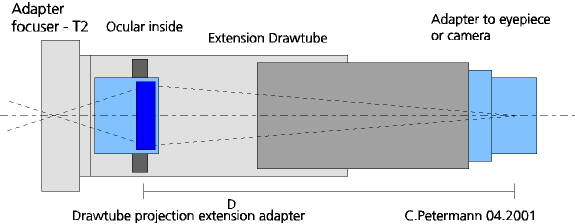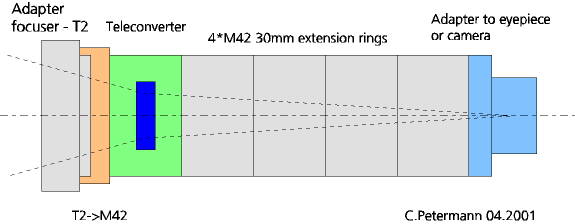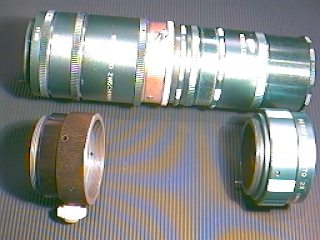
| Christoph Petermann | Homepage |
|
Astrophotography - Technical Material | Part 1
|
Last Update: 08 April 2001
For imaging close-ups of the Moon and the planets it is necessary to extend the focal length of the telescope. There are two ways of how to realize this:
A good source for theoretical background is here at T.Legault on "How to adjust the focal length?". So it is not necessary to repeat this all here. I use both described ways of extending the focal length of my telescope.

This is the most popular method and the distinct industry offers a variety of focal extenders. Most extenders have T2 (M42*0.75mm) connectors and fit to the popular available scopes on the market.

For ocular projection I have an extension tube by MEADE, where I can insert an eyepiece. At the time I still owned the Vixen R114S Newton I used the original Vixen extender, which has a dovetail ring for easy camera rotation, but it did not have any T2 ring. The MEADE extension tube can be adjusted in length for setting the desired magnification factor. With my CCD camera I have about 90 mm and with my Nikon I may add 47 mm including the T2 - Nikon adaptation.
The greater the distance from the projecting lens the more flat the image appears.
For eyepiece projection you have A = D/Fe - 1.
I get good results with a 12.5 mm (A = 6.2) and a 18 mm (A = 4) Orthoscopic eyepiece for projection. The choice of the right lens takes a lot of time and I found out that an ocular with a good image for visual observation may not deliver a good image for projection. This is the case with my 9.7 mm Ploessl.

The image shows the system working very well with a factor 2 teleconverter. Factor 2 for a teleconverter means that this is only valid for the given system register. Here I put the camera adapter and the camera. Starting from the drawtube with a 54 mm to T2 adpter following a T2 (=M42*0.75) - M42 (M42*1.0) ring. Next comes the teleconverter factor 2 and then 4 * 30 mm M42 rings are attached. The distance from the lens to the CCD chip is 115 mm. With
A = D/Fb + 1 (Fb = assumed 50 mm) this gives me an amplification factor A of 3.3.
Teleconverters have the advantage, that they are calculated for a flat field at their designed register. Register is the distance from the lens fixature (bajonet (Nikon, Canon) or screw (M42)) to the focal plane. This differs from eyepieces which are optimized for field-of-view and transparency. In most cases they do not have a plane focus. They get close to that with long focal distances.
Can I use an eyepiece instead of a camera in the focal plane? Yes, by putting an eyepiece here you multiply your magnification with the formular above. My standard eyepiece is a 9.7 mm MEADE Ploessl, which gives a magification of 77.3x in my 150/750mm Newton. With the described factor of 3.3x I get 255x. I still have pinpoint stars, if collimation of the Newton is well done.

Here is a view of a teleconverter projection tube made out of fleamarket stuff having different lengths.
I am indeed surprised about the quality of this projection system. My results on imaging Jupiter with the small 100/1000mm Maksutov lens are really very good. I made CCD images and photos of Jupiter, Saturn and the Moon using this system with success. New webcam images are are astonishing sharp. I tried 2 teleconverters in a row, but this gave poor results.
Meanwhile a commercial product with a Flourite lens is available on the market. I do well believe that this Euro 500.- expensive piece of optics does a fabulous job.
Resume: The teleconverter will be good for magnification factors from 2 to 4 and for higher magnifications up to 8 I use the eyepiece projection adapter. My experience with the M42 teleconverter is very good. As an eyepiece is designed for visual purposes, it won't give a flat field anyway. Some oculars may get close to it like Orthoscopic systems. In test image I found my teleconverter always beeing at least a bit better. Indeed I work with both types of enlargement of the focal length. However using a factor which is too high result in a poor image.
|
Text and All Images are Copyright by Christoph Petermann
DF9CY
|
GO (back) and visit my homepage